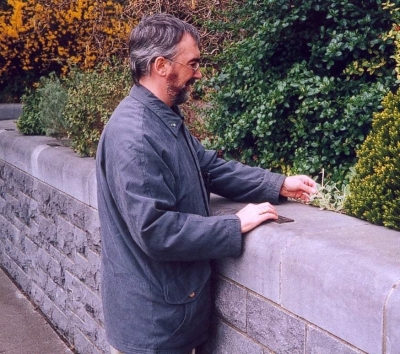This post is going to be about what it’s like to manage your money while blind. I’m sure there is plenty of prurient interest in the best way to scam a blindy, but I’m not going to cover that here. I am going to talk about just how useless, ableist and thoughtless government agencies and banks are when it comes to treating us as human beings with rights like everyone else.
My metaphorical eye (actually my ear) was caught by this Irish Times headline on 7th April 2020:
Coronavirus: Lack of electronic transfers for blind allowance causing hardship
The article by Social Affairs correspondant, Kitty Holland, was discussing the piecemeal approach of the HSE when it comes to issuing the Blind Welfare Allowance. Some regions are offering to issue the payment via Electronic Funds Transfer (EFT), while other regions persist in sending out a physical cheque, which needs to be taken to a physical bank branch and physically lodged into an account. In this era of social distancing, self-isolation and cocooning, this presents a real challenge to blind people trying to stay healthy.
But the problems are deeper, further back in time and more bizarrely convoluted than that. Strap yourselves in…
You’re blind, not disabled….
If you are “registered blind” in Ireland, you are special. I mean that in the worst possible way. In terms of social welfare supports, we’re not treated like other disabled people. We receive the Blind Persons’ Pension, not a Disability Benefit. As the “Pension” part of our payment suggests, the payment is managed by the Old Age Pension office – just one of many examples of structural ableism, lumping the disabled and the elderly together. I’ve been a pensioner since I was 18.
Here’s one example of just how ludicrous that system is. While I was at university, I went onto the “Back to Education Allowance” – another misnomer, as I had been in education continuously since the age of 2. The allowance meant I could access an annual book allowance, and could essentially hang on to all my other benefits. When I finally left university, I was setting up as a self-employed sole trader, and wanted to switch onto the “Back to Work (Enterprise) Allowance”. Again, a misnomer, as I hadn’t been technically unemployed. Again, this was a scheme that facilitated me hanging on to benefits while setting myself up as self-employed. Imagine the day when I rang up the Old Age Pension office:
“Hello; I’m currently on the Back to Education Allowance, and I want to switch to the Back to Work Enterprise Allowance.”
“Ummm…. Hang on there while I transfer you to someone else.”
I got transferred about 5 times. Sure why would anyone in the Old Age Pension office know the first thing about either Educational or Work benefits?
So what’s this Welfare Allowance thing?
Good question. On top of the weekly Blind Pension, whereby I qualify essentially for the maximum amount of social welfare, there’s a means-tested Blind Welfare Allowance. I get this monthly, and it’s meant to “offset the additional costs associated with being blind”. It’s not enough to pay for specialised eyewear, magnification, Braille production, assistive technology or even having a working iPhone, (rapidly becoming the de facto do-everything assistive bit of kit for blindies). My Welfare Allowance tends to cover getting an order of toiletries, some books, new underwear…. anything that isn’t a daily or weekly expense, but requires a bit of capital. Shouldn’t that kind of thing be covered by the weekly basic payment? Yes; yes it should, as many people on emergency benefits during the Covid-19 crisis have discovered. As soon as there was a massive increase in the number of people signing on for unemployment benefits, those who expected their jobs back afterwards kicked up shit about how little money they were expected to live on, and the government increased that payment from €220 per week to €350 per week.
I dream of such riches.
But there’s Braille on ATMs, right?
On to the banks. These are becoming less accessible as time goes on. The Braille markings on ATMs are really just adding insult to injury. Fine, I can tell that this is button number 1 and that is button number 6. But there’s no way in hell of finding out what those buttons actually do. I once tried to use an ATM that had a little headphone socket to hear what was on the screen. In fact, I deliberately moved my account to that bank (which no longer exists) because they had a lovely ramp up to their door, push-button doors into the branch and this magic ATM. Imagine my surprise when no audio came through my headphones. It might have had audio information when it was first installed, but no-one had checked that it was still working. They might never have checked it at all.
But I’m sure many bankers have seen those Braille-marked buttons and assumed that it made the machines totally accessible. The concept can be quite difficult to explain to Ableds. I once had to explain to a local authority that their info-terminals were no use to a VIP, even with JAWS installed. If you can’t see the touchscreen, how do you know which part of the screen to touch to make it talk?
Then there’s the increased automation of bank transactions; a transparent move by corporations to save money by employing fewer humans. This is the same trend that has seen smaller, rural branches cut to destruction. My local bank branch has a load of machines which they do everything in their power to make you use instead of going to a counter and speaking to a human. By “everything in their power”, I include the practice of charging 600% for a “staff-assisted” transaction in comparison to an automated transaction. I’ll say that again. If you go to a counter and lodge your Blind Welfare Allowance cheque with a member of staff, it will cost you 6 times as much as using one of the machines.
Why not just use the machines?
I sincerely hope, dear reader, that you can guess where this is going. The machines are not accessible to VIPs. Furthermore, in my local branch, they are surrounded by privacy shields which don’t provide enough space to get near them in a wheelchair . So disabled clients have no choice but to make “staff-asisted” transactions, and pay 6 times as much for the privilege.
I’m not even going to approach the tawdry history of my struggles with online banking, especially with the use of card-readers with tiny buttons and invisible screens. Back to the Kitty Holland article…
Cheques and Balances
Aside from the usual thrill of coming across any mention of disability in mainstream media, this article grabbed my attention because I had just been sent a letter about this very issue. And yes, I mean a letter. In tiny print. In the post.
I could tell that it was from the HSE because their logo was on the envelope. So I didn’t even bother opening it until my trusty PA came round. She’s my trusty PA because she’s the one I trust to see me naked, file my private papers and have access to my bank details. When she arrived for work, I handed her the letter, saying “This is probably another normal-print letter from the HSE saying: We’ve just realised how ludicrous it is to keep sending you cheques when you’re not supposed to leave the house at the moment, so here’s a form you can’t read so that we can finally lodge the money straight into your account, which will also save your extravagant bank charges.” To my astonishment, my PA said “Yes, but not in those exact words!”
To recap, this was a letter and a form being sent out exclusively to blind and visually impaired people. Neither the letter nor the form was in an accessible format, and the form required filling in by hand. Their only nod to alternative formatting was the possibility of emailing the completed form back to them. So when I emailed it to them, this was the body text I included with my message:
Please find attached my form requesting a change to receiving my blind welfare allowance.
- The letter should have been sent in an accessible format – I use Braille
- The form should have been available in an accessible digital format.
My rights to financial autonomy and privacy have been violated, as I had no choice but to get a third party to fill in this form. Further, the form was not specific to people in receipt of benefits, and as such, was confusing and made us feel like an after-thought, not a priority.
As you are managing a fund specific to blind and visually impaired people, you should instigate policies of informational accessibility as a matter of urgency. It is your obligation under the UN Convention on the Rights of People with Disabilities (CRPD), to which Ireland is a signatory.
Why do I still have to send these messages to government agencies? Especially those tasked with supporting VIPs and disabled people? It’s getting old, and the novelty is wearing very thin.










